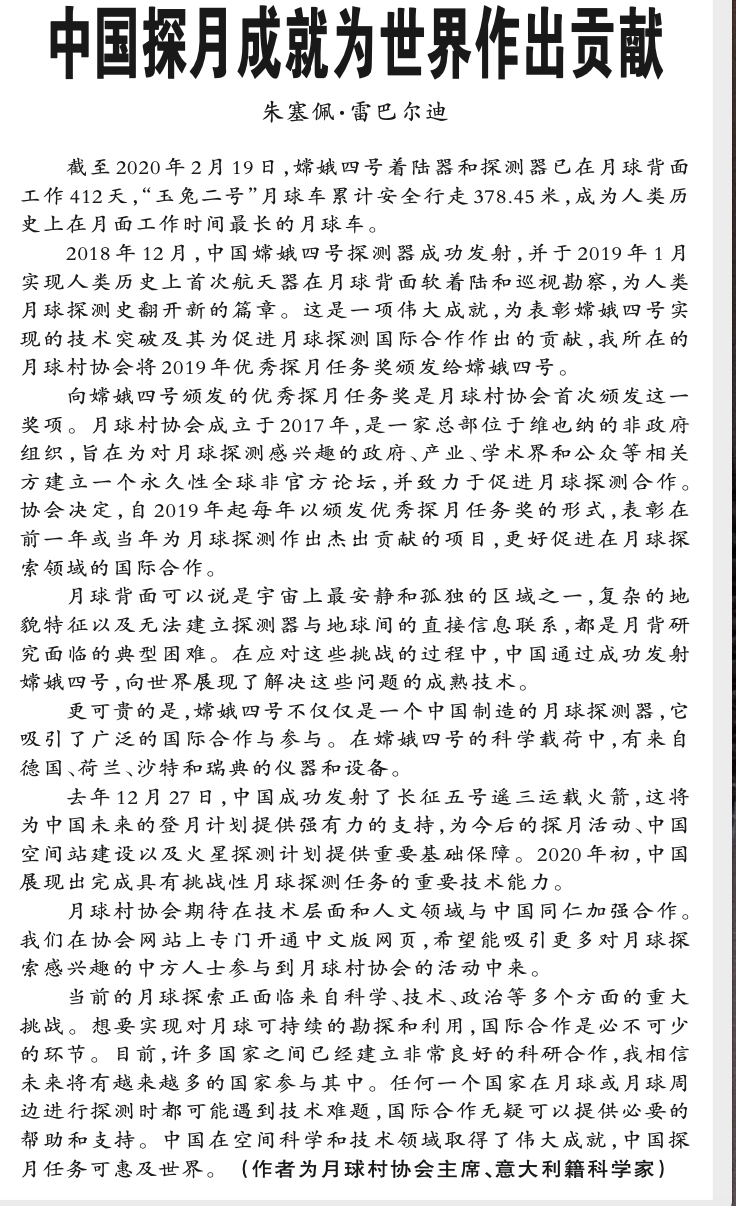Article about MVA that was published on Peoples Daily Newspaper in China, on February 19
Achievement of Chinese Lunar Exploration made its contribution to the world
By Giuseppe Reibaldi
As of February 19, 2020, the Chang’e 4 lander and probe have been working on the back of the moon for 412 days, and the “Yutu 2” lunar rover has safely moved 378.45 meters, becoming the longest working lunar rover on the moon in human history.
In December 2018, China’s Chang’e-4 probe was successfully launched, and in January 2019, it achieved the first soft landing and patrol survey of on the far side of the moon in human history, opening a new chapter in the history of human lunar exploration. This is a great achievement. In recognition of the technological breakthrough achieved by Chang’e-4 and its contribution to promoting international cooperation in lunar exploration, the Lunar Village Association awarded the 2019 Outstanding Lunar Mission Award to Chang’e-4.
The Outstanding Lunar Mission Award is the first such award awarded by the Moon Village Association. Established in 2017, the Moon Village Association is a Vienna-based non-governmental organization that aims to establish a permanent global unofficial forum for governments, industry, academia and the public interested in lunar exploration, and is committed to promote cooperation in lunar exploration. Starting from 2019, our Association has decided to honour projects annually that have made outstanding contributions to lunar exploration in the previous year or the current year to promote international cooperation in the field of lunar exploration.
The far-side of the moon is arguably one of the quietest and lonely regions in the universe. Complex geomorphological features and the inability to establish a direct communication link between the probe and the earth are typical difficulties faced by lunar exploration there. In tackling these challenges, China successfully demonstrated to the world its mature technologies for solving these problems through the successful launch of Chang’e-4.
What’s more valuable is that Chang’e-4 is not just a Chinese-made lunar probe, it has attracted extensive international cooperation and participation. Among the scientific payloads of Chang’e-4, several instruments and equipment come from Germany, the Netherlands, Saudi Arabia and Sweden.
On December 27 last year, China successfully launched the Long March 5 Y3 carrier rocket. It will provide strong support for China’s future moon landing plan, and offer an important foundation for future moon exploration activities, the implementation of the Chinese Space Station, and the Mars exploration plan as well. In early 2020, China demonstrated its key technical capabilities to complete challenging lunar exploration missions.
The Lunar Village Association looks forward to strengthening cooperation with Chinese colleagues at the technical areas and the humanities. We have launched a Chinese version of the website on the association’s website, hoping to attract more Chinese people interested in lunar exploration to participate in the activities of the Lunar Village Association.
The current moon exploration is facing many challenges from different aspects such as science, technology, and politics. To achieve sustainable exploration and use of the moon, international cooperation is an essential link. At present, many countries have established very good relation for scientific cooperation. I believe that more and more countries will get involved in this kind cooperation in the future. Any country may encounter technical difficulties when conducting exploration on or around the moon itself, and international cooperation can undoubtedly provide necessary support. China has made great achievements in the field of space science and technology, and China’s lunar exploration mission can benefit the world.





You must be logged in to post a comment.